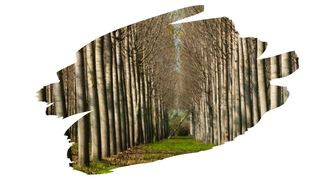Danish oil is all the rage. This is because this incredibly popular finish dries faster than other oils like Linseed and Tung oil.
And once cured, it leaves behind a satin looking finish that really brings out the wood grain detail on almost any wooden surface – including Oak, Pine, and Beech.
But would Danish oil make for a great oil finish on Poplar wood too?
Danish oil will do a great job at soaking into Poplar woods porous grain and protecting it from moisture. But while Danish oil is a decent oil finish, Poplar wood doesn’t take well to finishes and stains.
That is because Poplar wood is what we call a ‘Paint-Grade’ wood type. Which is basically a quick way of saying that the only finish you’ll want to use on it is Paint.
Why? Well, because poplar doesn’t take on stains or finishes evenly. This leaves stain coats looking blotchy, and oil finishes appearing uneven.
In other words, Poplar is usually painted over in order to give it a bit of color. But that does not mean your dreams of finishing Poplar with Danish oil are over just yet…

This post may contain affiliate links to products that we receive a commission for (at no additional cost to you). Learn more here.
So, What Is The Best Finish For Poplar Wood?
Honestly? A coat of paint.
Poplar wood is paint-graded exactly because it is the only type of finish it takes well too.
That is because the grain of this lumber is fairly inconsistent. Some parts are ‘spongier’ than others. Which means those spongey areas will absorb an oil finish or stain faster than other spots.
The end result of which is a blotchy wooden surface.
Related Post: What To Do When Staining Over Wood Filler Gives Blotchy Results

But, How Do You Finish Poplar Naturally (Without Paint)?
It can be a little tricky, (and sometimes more than a bit frustrating), but you can use a natural oil finish.
But you can only do this provided that you apply a treatment to Poplar wood first. This treatment involves applying wood conditioner onto Poplar, before you coat on any of the oil.
Related Post: Should I Apply Wood Conditioner Before Danish Oil? (Explained)
The point of applying wood conditioner first is to get the conditioner absorbed into those spongy areas, packing them out. And afterwards, when you apply Danish oil, the oil gets absorbed (in those particular areas) at a slower rate. And, ideally, the Danish oil coat will leave behind an even looking surface.
At least that’s the plan in theory.
In practice, however, wood conditioner is typically used on knotty woods – like Pine – or porous woods such as Maple and Birch. In those cases, the oil finish is unevenly absorbed due to wood pores or open holes in the wood.
Poplars absorption problems, on the other hand, stem from the very texture of Poplar wood itself… that random sponginess.
So, using wood conditioner on Poplar wood (to help even out an oil finish) is still a bit of a shot in the dark.
Does Danish Oil At Least Make Poplar Wood Darker? Yes, it does, mostly thanks to the pigment stains added to this natural oil blended product.
Related Post: All About Danish Oil: Advantages and Disadvantages
So To Wrap Things Up…
To be completely honest, you are better off applying a coat of paint on Poplar wood to finish things off.
Laying on a natural oil, like Danish oil, is going to be fairly tricky to get right.
However, you can prep Poplar wood with a wood conditioner first, and see if that will help with evening things out.
And, worse comes to the worst, if you don’t manage to get the natural oil finish that you wanted – you can still paint over it anyway.


